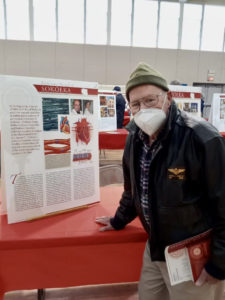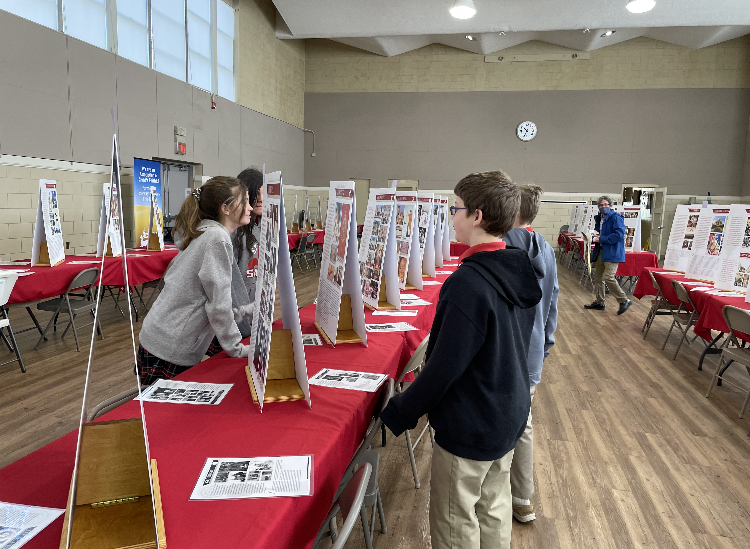Touring display, created by Blessed Carlo Acutis, is being shown at Diocese of Knoxville locations
By Janice Fritz-Ryken
Parents often complain that teens’ lives are run by computer technology, and yet one inspirational teenager in Italy used the computer to evangelize Christ and create an exhibit that is still drawing people to Christ 16 years after his death.
Freezing rain and the threat of black ice over the long Martin Luther King Jr. holiday weekend Jan. 15-17 did little to stop hundreds of faithful Catholics from visiting St. Jude School in Chattanooga to see the awe-inspiring exhibit of eucharistic miracles displayed in the school’s cafeteria.
The exhibit was at Knoxville Catholic High School Feb. 5-6.
The exhibit, created by the recently beatified Blessed Carlo Acutis, did not disappoint those who made the trek through the blustery weather, especially those closer to the age of the possible saint.
One such visitor was Eric Higgins, a sixth-grader at Our Lady of Perpetual Help School in Chattanooga. When Eric learned the exhibit was coming to town, he told his mom, Kristy, they had to go see the miracles. Eric was especially interested in the young man who was not much older than he is right now when he created the exhibit.
“Eric really wanted to be here. It was important to him,” said Kristy Higgins. “He studied about the saints and the miracles in class and felt drawn to it, perhaps because he is preparing to be confirmed later this year.”
 Eric said his favorite miracle happened in Buenos Aires, where a priest placed a defiled host found on the floor of his church in water to dissolve it in August 1996. Within a few days, not only did the host not dissolve, but it grew in size and developed real blood. After much scientific vetting, the Vatican has now recognized this as a true eucharistic miracle, and the host still is on display today.
Eric said his favorite miracle happened in Buenos Aires, where a priest placed a defiled host found on the floor of his church in water to dissolve it in August 1996. Within a few days, not only did the host not dissolve, but it grew in size and developed real blood. After much scientific vetting, the Vatican has now recognized this as a true eucharistic miracle, and the host still is on display today.
“The blood just can’t be explained scientifically. It’s real; the host has never spoiled or dissolved, and they can’t explain it away as a scientific thing. It’s a true miracle,” said Eric, who noted that the images on display helped him to visualize the real presence of Christ in Communion. Looking at the panels and photographs of the bleeding host, he said, “It makes me feel closer to Jesus. I hope my friends come see this because I know it will help them to believe even more.”
The Catholic Church teaches that when the words of consecration are spoken at Mass, bread and wine are transformed into the Body and Blood of Christ, but typically they retain the appearance of bread and wine. The Blessed Carlo Acutis exhibit focuses on those extraordinary historical instances when the bread and wine have inexplicably been physically changed into human flesh and blood in a manner that has baffled scientists and proves what Catholics believe…that Jesus is really and truly present in the Blessed Sacrament.
For three days, people flocked to visit the large, colorful panels of illustrations, photographs, and historical descriptions of 140 eucharistic miracles that were scientifically vetted and are recognized by the Vatican. Many said it felt like a virtual tour of the places where the miracles occurred.
“It’s as if you’ve been on a worldwide pilgrimage,” said Sandy Leffew, a parishioner of St. Jude who helped organize the exhibit. Ms. Leffew said she marveled at the lines of people filtering in and out all weekend, despite the warnings of freezing weather. Many visitors even came more than once.
“The entire exhibit is a lot to take in, and the stories are all so amazing. People said they didn’t expect it to be so big. Many were overwhelmed and needed more time to see it all,” Ms. Leffew said. “But everyone who came said it was worth the risk. We hope this deepens peoples’ love of the Eucharist and shows the many ways in which the Lord shows His face.”
This was definitely the case for Pat Crowe, a retired military veteran and St. Jude parishioner from Hixson, who said the display greatly affected him even after he’d gone home. He felt called to return.
“It was absolutely incredible,” Mr. Crowe said. “I was here all morning reading about the miracles, looking at the images. Then I went home and took a nap. I actually dreamt about the miracles, so as soon as I woke up I went back because after my dream I suddenly wanted to see the Lanciano miracle.”
 The Lanciano Miracle tells the story of one of the first miracles that took place in eighth-century Italy, when a monk celebrating Mass had a quiet doubt about whether it was the real presence of Jesus in the host. As he pronounced the consecration of bread and wine, he suddenly saw the consecrated bread turn in to Flesh and the wine into Precious Blood. The exhibit shows the pictures of the actual Flesh and Blood still on display in Lanciano, Italy.
The Lanciano Miracle tells the story of one of the first miracles that took place in eighth-century Italy, when a monk celebrating Mass had a quiet doubt about whether it was the real presence of Jesus in the host. As he pronounced the consecration of bread and wine, he suddenly saw the consecrated bread turn in to Flesh and the wine into Precious Blood. The exhibit shows the pictures of the actual Flesh and Blood still on display in Lanciano, Italy.
For Alan and Teresa Robinson of Ooltewah, the familiar story of St. Bernadette in Lourdes, France, was just one panel they stopped to read.
“You grow up learning of the more popular saints and their stories, like with St. Bernadette, and it’s nice to revisit the stories. Life can get busy, and sometimes we focus on the difficult things and you forget these stories you heard growing up. When you see all of the miracles lined up side by side, it’s truly incredible,” Mr. Robinson said.
St. Jude parishioner Paul Trudel said in reading through the exhibit he managed to generalize the stories of the miracles into four categories:
- Priests who either didn’t believe or lost their belief in the true presence, in which case the host bled or turned to flesh;
- People who received Communion and then the host bled or turned to flesh;
- Stolen hosts. The hosts could not be hidden; they became so heavy they could not be carried or they became suspended in the air or illuminated;
- Several stories where certain people were sustained by the Eucharist alone for decades, proving that Christ is the true sustenance.
Teresa Slaughter, a St. Jude parishioner, said people with any feelings of doubt had hundreds of examples of Christ’s existence to strengthen their faith through this exhibit.
 “I’ve been a believer my entire life,” Ms. Slaughter said. “But if I had any doubts, this exhibit would restore my faith, and more importantly I know it would strengthen the faith of our younger generation.”
“I’ve been a believer my entire life,” Ms. Slaughter said. “But if I had any doubts, this exhibit would restore my faith, and more importantly I know it would strengthen the faith of our younger generation.”
To Ms. Slaughter, the story behind the exhibit is as important as the exhibit itself.
“You can’t talk about the exhibit without talking about Carlo,” she said. “He was a regular kid with so much faith. He played soccer; he enjoyed being on his computer; he was an ordinary kid who did holy things. Carlo resonates with our youth. He’s someone the younger generation can relate to and someone who used technology to draw others to Christ. He inspires younger people to sainthood. I’m so grateful this young man took the time to put this exhibit together in his short life.”
Laquada Florek agrees. “Witnessing bread and wine turning into Jesus’ true Flesh and Blood is a true miracle. Any unbeliever will surely have a change of heart. It was exhilarating, and I will have even more love, respect, and devotion the next time I receive Jesus in the Holy Communion.”


Comments 1
What a joy to be involved in bringing this exhibit to Chattanooga and Knoxville for the edification of all East Tennessee. Folks came from north Georgia, Kingsport, and all points beyond. Travelers from California, Michigan and Florida who were passing through and saw the announcement in church bulletins joined in viewing the display. So many whose hearts were touched expressed gratitude in this exhibit and felt an increased awareness of what they receive in the reception of Holy Eucharistic. I am grateful to those who attended and helped in hosting this wonderful display.